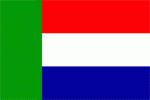
South African Republic
Republic

Transvaal
British colony
Quick reference
General issues:
- South African Republic 1869-1877, Transvaal, British colony 1877-1881, South African Republic 1881-1902, Transvaal, British colony 1900-1910
Country name on general issues: Z. Afr. Republiek, Zuidafrikaansche Republiek, Transvaal
Special issues:
- South African Republic occupation issues Vrijburg 1899
- British local occupation issues Lijdenburg, Rustenburg, Schweizer Reneke, Volksrust, Wolmaranstad 1900-1902
- South African Republic, local issues Pietersburg 1901
Related issues: Local issues Mafeking, Vryburg 1900
Currency: 1 Pound = 20 Shilling, 1 Shilling = 12 Pence 1869-1910
Population: 972 000 in 1901
Political history Transvaal
The Great Trek
Transvaal is located in southern Africa – north of the Vaal River. The first colonists settle in Transvaal in the first half of the 19th century. After the British have taken over Cape of Good Hope from the Dutch in 1814, the descendants of the original Dutch settlers – the Boer – embark on the so called ‘Great Trek’. In the 1830’s and 1840’s, the Boer move inland and establish a number of republics – some of which only have a short existence. In 1853, the South African Republic is formed in Potchefstroom.
Shaping the South African Republic
The South African Republic will, in subsequent years, absorb several of the Boer republics established north of the Vaal River: in 1860 the Lijdenburg republic – including the republic of Utrecht that had joined the Lijdenburg republic in 1858, in 1864 the Zoutpansberg republic, in 1888 the New Republic and in 1891 the small Klein Vrystaat. Furthermore, between 1871 and 1884, the borders of the South African Republic will be adjusted several times through treaties with the British – extending its territory westward into the land of the Tswana. In 1881, minor border adjustments with Mozambique are agreed upon with the Portuguese.
The First Boer War
The British, from the 1870’s, take an ever growing interest in the South African Republic. First, because of the mineral resources that are discovered – diamonds and gold. Second, because the British in the ‘Scramble for Africa’ want to prevent other colonial powers from annexing the South African Republic. In 1877, the British decide to annex the South African Republic as the British colony of Transvaal. The Boer reject British annexation and, in 1880, start the First Boer War that ends in the reestablishment of the South African Republic in 1881 – until 1884 under British sovereignty, from 1884 fully independent.
The Second Boer War
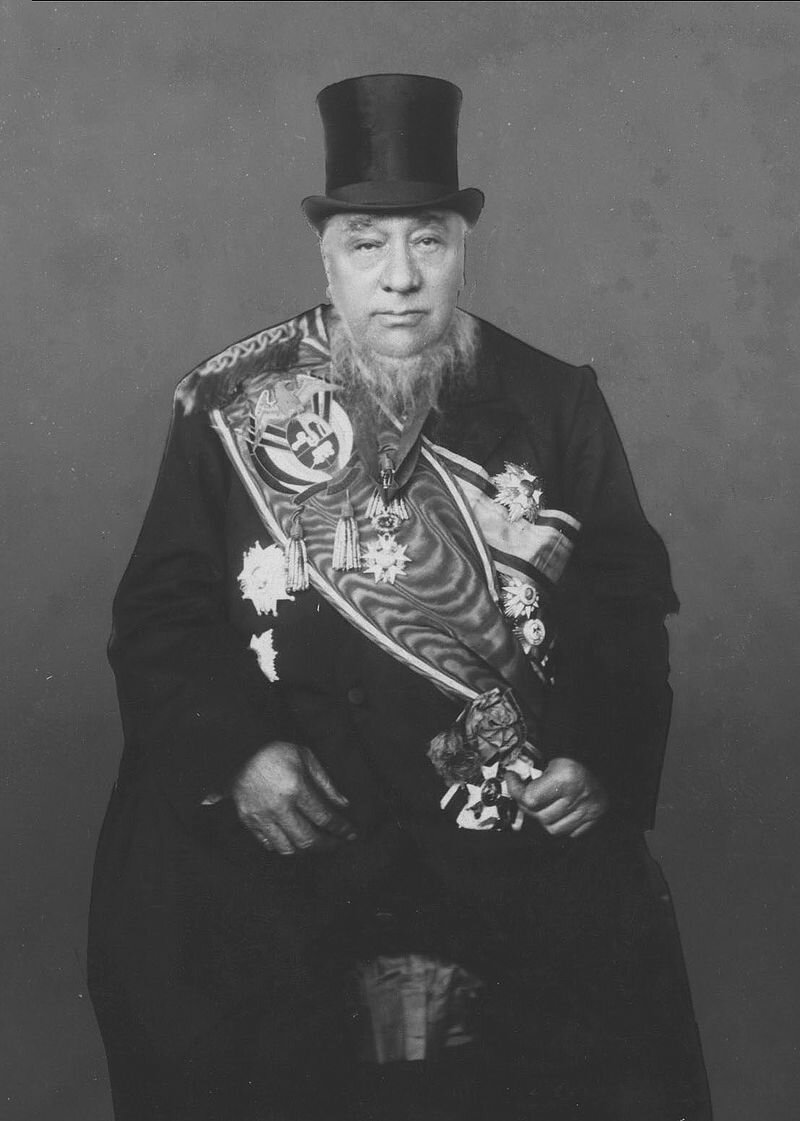
Paul Kruger – President of the South African Republic 1883-1900
In the 1880’s and 1890’s, the South African Republic extends its influence in neighboring Swaziland, that, in 1894, becomes a protectorate of the South African Republic. In the 1890’s, the South African Republic develops closer ties with the other large Boer republic – Orange Free State – resulting in a treaty between the two Boer republics. Increasing tension with the British, in 1899, leads to the Second Boer War. The Boer, from Orange Free State and the South African Republic, invade the British colonies of Cape of Good Hope and Natal. The British, however, quickly gain the upper hand and, by 1900, large parts of Orange Free State and the South African Republic are occupied by the British. The Boer resort to a guerrilla war – the last Boer to surrender in 1902. The British annex Orange Free State and the South African Republic as the Orange River and Transvaal colonies – de facto in 1900, de jure in 1902. The borders of Transvaal are adjusted by the transfer of the territories of the former republic of Utrecht and the New Republic to Natal.
Aftermath
The Transvaal colony will, in 1910, join the Union of South Africa. Transvaal will be province of South Africa until 1994, when it is split up into four smaller provinces that exist until today.
Postal history Transvaal
General issues
The South African Republic and the Transvaal colony have both issued stamps for general use in each of the two periods of their existence.
- First South African Republic – In 1869, the first stamps are issued by the South African Republic, showing the coat of arms of the republic. At the time, there were 12 post offices in the South African Republic. Stamps of this design are issued until 1877.
- First Transvaal colony – When the British, in 1877, annex the South African Republic, they issue provisionals – stamps of the South African Republic overprinted ‘V.R. Transvaal'[1]‘Victoria Regina Transvaal’ or ‘Victoria Queen of Transvaal’ – and, in 1878, a set of definitives inscribed ‘Transvaal’. The latter being overprinted with new face values in 1879.
- Second South African Republic – Having been reestablished, the South African Republic resumes to issue stamps in 1882. The first issue is a provisional – an overprint with a new face value on one of the 1878 Transvaal issues. In 1883, the earlier coat of arms design is used for the first set of definitives. New designs follow from 1885. The last issue for general use is issued in 1897.
- Second Transvaal colony – General issues for the occupied parts of the South African Republic are issued by the British between 1900 and 1902 – stamps of the South African Republic overprinted ‘V.R.I.'[2]‘Victoria Regina Imperatrix’ or ‘Victoria Queen & Empress’ and ‘E.R.I'[3]‘Edward Rex Imperator’ or ‘Edward King & Emperor’ . Next, from 1902 until 1909, definitives are issued for the Transvaal colony – again inscribed ‘Transvaal’.
The stamps of the Transvaal colony are, from 1910, superseded by the stamps of the Union of South Africa. The stamps of Transvaal will be valid for use in the Union of South Africa until 1937.
Special issues Second Boer War
The Second Boer War will lead to a number of provisional issues:
- In Cape of Good Hope the Boer issue provisionals when they occupied Vryburg in October 1899. The issues are overprints on stamps of the Cape Colony reading ‘Z.A.R.’[4]Z.A.R. is short for Zuid Afrikaansche Republiek, the name of the South African Republic in Afrikaans. and a new face value.
- Once the British have recaptured Vryburg in May 1900, they too issue provisionals for use in Vryburg – stamps from the South African Republic overprinted ‘V.R. Special Post’.
- Also, in Cape of Good Hope, the British issue provisionals during the siege of Mafeking by the Boer from November 1899 until May 1900. First, available stamps of the Cape Colony and Bechuanaland – both British Bechuanaland and Bechuanaland Protectorate – are overprinted ‘Mafeking Besieged’ and a new face value. Next, two stamps of local design and print are issued.
- In the occupied parts of the South African Republic, the British locally issue stamps between June 1900 and March 1902 at the towns of Lijdenburg, Rustenburg, Schweizer Reneke, Volksrust and Wolmaranstad. Most of these are handstamped overprints on stamps of the South African Republic – the overprint reading ‘V.R.’ or ‘V.R.I.’. In Schweizer Reneke stamps both of Cape of Good Hope and the South African Republic were overprinted ‘Besieged’ – the British having taken the town, but being under siege of the Boer.
- The final issue in the name of the South African Republic is a local one – issued in 1901 at the last stronghold of the Boer in Pietersburg, stamps of local design and print authenticated by hand with the signature of the postmaster.
With the exception of the Pietersburg issue, these special issues are all in the higher to very high catalog value ranges.
Album pages
← Previous page: TranskeiNext page: Tristan da Cunha →

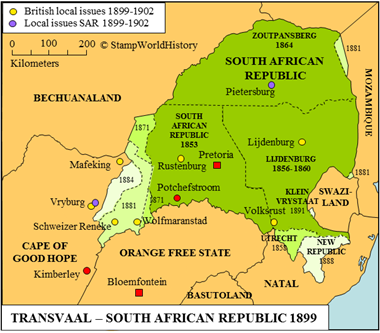
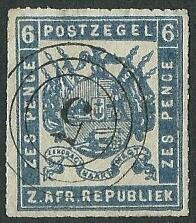
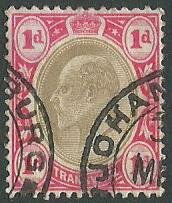


Illustrating a genuine copy of the 1st republic stamp would be more appropriate for this reference page!!
John
Thanks for your response. What makes you say this is not a genuine copy?